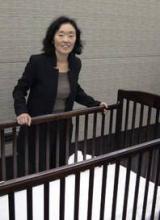BOSTON – Plush, soft, fuzzy, warm, and cuddly – those seem like the perfect attributes for a newborn nursery.
Except if you’re the newborn.
A new policy from the American Academy of Pediatrics says that babies who sleep on their back on a firm, flat surface – in their own unadorned crib – are most protected from sudden infant death syndrome (SIDS) and the deadly related tragedies of suffocation, asphyxiation, and entrapment.
The AAP released its newest guidelines Oct. 18 for infant sleep safety and SIDS risk reduction (Pediatrics 2011 Oct. 17;doi:10.1542/peds.2011-2285). The take-home message for pediatricians and parents alike is a simple one, Dr. Rachel Moon said at a press briefing.
"Put baby on the back for every sleep. Use a firm sleep surface designed for infants, with no soft objects, wedges, positioners," or any other fashionable accoutrements such as ruffles, blankets, crib drapes, or bumper pads.
The ideal sleeping set-up? A crib, bassinet, or portable crib/play-yard in mom and dad’s room, with a firm mattress, a tight-fitting bottom sheet, and no blanket or other baby-dangerous decorative items.
Although such adornments may satisfy a parent’s fashion sense, they make no safety sense at all, said Dr. Moon, the policy’s primary author and a pediatrician at the Children’s National Medical Center, Washington.
Since 1992, when the AAP first launched its "Back to Sleep" campaign, SIDS cases in the United States have decreased by 50%. "But we’ve seen an alarming increase in other deaths," Dr. Moon said. "There has been a quadrupling of infant deaths due to suffocation and entrapment, and a lot of this is attributable to inappropriate bedding and to cosleeping" with parents.
Those deaths – grouped together as sudden unexplained infant deaths (SUID) – can’t always be distinguished from SIDS, she noted. SIDS infants probably have some vulnerability that predisposes them to an unexplained death, whether that is an inborn error of metabolism, prematurity, or exposure to cigarette smoke. SUID may occur either among those infants or among those who have no identifiable risk factors. Other than a coroner’s exam – almost universally unhelpful – there’s no way to tell these deaths apart.
The safest course is to make sure that infants have the safest possible sleep accommodations. The bare crib eliminates a number of dangerous factors that can cause an accidental infant death.
The new policy also tackles the controversial subject of cosleeping. The family bed has been promoted among many circles as the most natural way to care for a newborn. Some groups – and even physicians – have suggested that cosleeping may help prevent SIDS.
There are no data to support those claims, Dr. Moon said. In fact, cosleeping can put the infant at risk of smothering under heavy covers, airway obstruction if an adult limb falls across its face, and even overheating – a recognized SIDS risk factor.
Bed sharing is even more dangerous with adults who are medicated or have consumed alcohol or drugs, Dr. Moon added. Those adults will be less aware of their movements and whether they might endanger the sleeping infant.
"There has been a quadrupling of infant deaths due to suffocation and entrapment, and a lot of this is attributable to inappropriate bedding and to cosleeping."
Parents shouldn’t worry that babies might choke on their own secretions when sleeping on their backs, Dr. Moon said. Babies have built-in protective physical guards against choking. There’s also no evidence that placing newborns on their sides helps drain amniotic fluid or other secretions from their lungs. Moms who choose rooming-in after delivery should also put their baby to sleep in the supine position and request that nurses do the same.
Preterm babies and those with low birth weights are especially at risk for SIDS, Dr. Moon said. Even infants in the neonatal intensive care unit should sleep supine as soon as they are medically stable.
The AAP policy stresses the protective influence of breastfeeding, but notes that infants who come to the adults’ bed for nighttime nursing should go back to their own crib after feeding.
"Because of the extremely high risk of SIDS and suffocation on couches and armchairs, infants should never be fed on a couch or armchair when there is a high risk that the parent might fall asleep," according to the policy’s authors.
The AAP policy gives the pacifier its proper place as well. Pacifiers seem to protect against SIDS, although the mechanism isn’t really understood, Dr. Moon said. "It seems to have something to do with stimulating arousal," as the babies suck during sleep.


